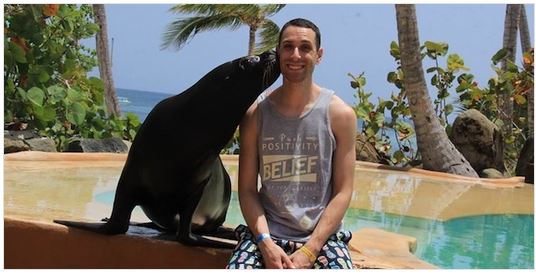SLP Corner: Using Your Cell Phone Photos as Speech Therapy Story Starters
by Erik Raj, M.S., CCC-SLPLP

What is one thing that all of us speech-language pathologists have in common? If you answered that we’re all awesome, you’re right, but that’s not exactly the response I was looking for, haha! The one commonality that I believe we all share is the fact that we all have a cell phone in our pockets. And I am willing to bet that not only does your cell phone house the phone numbers of your favorite contacts, but it also contains a massive amount of photos that you have taken, thanks to its camera capabilities. So my real question is – did you know that the personal photos on your cell phone could easily be repurposed as speech therapy story starters? Check out some of my examples below:
Example 1 – Say hello to Stella!
Cell phone photos of animals almost always trigger a ton of spontaneous conversation in my speech therapy room (hence, that picture of me and the seal at the top of this blog post). Pets are a great thing to share with your students. For example, all of my students know that I have a dog that I adore named Stella. Click HERE to see a cell phone photo that I shared of my pooch. Notice how my doggy is wearing some winter boots in the picture? It was fantastic to hear one student start off her story by saying, “Mr. Raj’s dog was participating in a fashion show and the grand prize was a dog bone necklace.” How nice!
Example 2 – Check out my snowman!
I’m a child at heart, so when it snows, I get excited! Click HERE to see a cell phone photo that I shared of me building a snowman. Notice how the snowman is taller than me? One student saw that photo and verbalized an amazing story that had to do with the snowman and I starting a basketball team together. “That snowman is really tall, so I know he can dunk a basketball easily!” exclaimed the young story teller.
Example 3 – You will never guess who I met!
Sometimes I get the chance to meet celebrities! Click HERE to see a cell phone photo that I shared of me posing with Dr. Seuss’ the Cat in the Hat. Not only did my younger students think I was super cool because I was hangin’ with an iconic children’s book character, but they also crafted some mind-blowing stories. “Then out of nowhere, Mr. Raj stole that cat’s hat. The cat chased Mr. Raj all over the city trying to get it back!” That student went on to tell me one of the most hilarious stories I have ever had the pleasure of hearing.
Get to know your kiddos!
By sharing personal photos from your cell phone, you are able to do two things. The first is that you get the opportunity to share personal information about yourself with your students (and this helps to build trust), and the second is that the students become more comfortable with sharing personal information with you (and this helps to reinforce trust). As I have wrote about in the past, getting to know your students and building their trust is key.
In closing . . .
Sharing my personal cell phone photos with my students has proven to be an exciting story starter activity. Through my photos, I am able to effortlessly encourage creative thinking and imaginative (and descriptive) conversation. Do you think that this idea might mesh well with your students? Are you already doing something like this? As always, I would love to hear from you.
P.S. Speaking of personal photos, sometimes I even bring in pictures of me when I was a little kiddo. Read all about how I introduce baby pictures within the speech therapy setting by clicking HERE.
Featured Contributor: Erik X. Raj, M.S., CCC-SLP
Erik X. Raj, M.S., CCC-SLP is a practicing speech-language pathologist and app developer living in Detroit, Michigan. Originally from Jackson, New Jersey, he received his B.S. from Richard Stockton College of New Jersey and was awarded a M.S. from Misericrodia University.
You can learn about Erik’s apps for speech-language therapy and read his blog on erikxraj.com
dup
PediaStaff is Hiring!
All JobsPediaStaff hires pediatric and school-based professionals nationwide for contract assignments of 2 to 12 months. We also help clinics, hospitals, schools, and home health agencies to find and hire these professionals directly. We work with Speech-Language Pathologists, Occupational and Physical Therapists, School Psychologists, and others in pediatric therapy and education.
